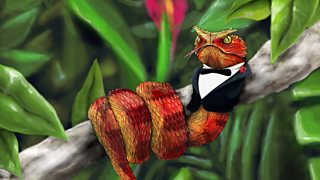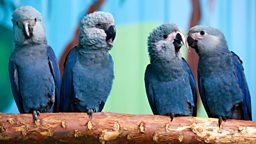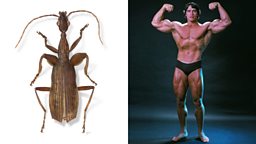11 fangtastic facts about snakes
1. Fangs a lot
The West African gaboon viper has the longest fangs of any snake. In a 6ft (1.83m) long specimen they measured 2in (50mm).

The snake with the largest venom fangs
Dr Ronald Jenner describes the head of a gaboon viper and the effects of its venom.
2. Swimmers
All snakes can swim and can stay under water for up to an hour.
3. Cannibalism
Female green anacondas, the larger of the sexes, have been reported to eat smaller males.
4. Snakes and ladders
The board game, snakes and ladders, was originally invented to be used as barometer of karma for Buddhists.

Snakes and ladders: a morality test
Catherine Howell from the V&A looks at a Victorian and early Indian version of the game.
5. Snake eyes
Snakes don’t blink as they have transparent eyelids that are fused shut. When they shed their skin they also shed these eye coverings, which are known as brille.
The lack of blinking may have led to the myth that snakes hypnotise their prey.
6. No ears
Snakes don’t have ears as we know them but instead vestiges of the apparatus for hearing inside their heads. They feel vibrations very well and may hear low-frequency airborne sounds.
It is thought that snakes hiss to warn other creatures.
7. The biggest
The anaconda is considered to be the biggest snake due to its sheer bulk. The largest measured was almost 28ft (8.5m) long with a girth of 44in (1.1m). Scientists estimate that it weighed over 500lb (226.8kg).
A python holds the record for length with the longest measured at 33ft (10m).

8. The most dangerous
Experts tend to name the black mamba and the coastal taipan as the world’s most dangerous, venomous snake species.
9. Pure poison
Snake venom can be divided into two broad categories although many snakes incorporate both in their bites:
• Hemotoxic venom affects the blood and organs
• Neurotoxic venom affects the nervous system
10. Snake-handling
Religious snake handling has been outlawed in most states in the US, including Kentucky and Tennessee.
Using serpents during services is a long-standing tradition but several snake-handlers have died after being bitten.
11. Go to work on an egg
Egg-eating snakes have few teeth so they can swallow an egg whole. Tooth-like spines on the underside of the neck bones crack open the egg once the snake has followed it.
Source: Natural Histories
Snakes
-
![]()
The head of Abruzziβs Viper family is ready to appoint a successor...
Mammoths
-
![]()
From flutes to fossils - read our fab facts about mammoths.
-
![]()
A Natural Histories Comedy featuring a size-conscious mammoth.
-
![]()
Brett Westwood hears how demand for mammoth ivory is growing.
-
![]()
Brett Westwood explores the role woolly mammoths have played in our lives.


















































